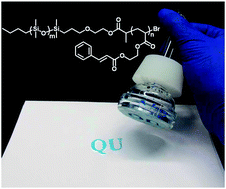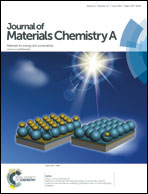Hydrophilically patterned superhydrophobic cotton fabrics and their use in ink printing†
Abstract
Poly(dimethylsiloxane)-block-poly[2-(cinnamoyloxy)ethyl acrylate], (PDMS-b-PCEA), has been synthesized and characterized. The copolymer formed micelles in mixtures of tetrahydrofuran and hexane. Treating cotton swatches by soaking them in micellar solutions, removing them, and annealing them at 120 °C after solvent evaporation yielded swatches with their fibers covered by the copolymer. Our X-ray photoelectron spectroscopy (XPS) and surface wetting property analyses indicated that the PDMS block topped the polymer coating. Photolyzing the cotton swatches under a mask crosslinked the anchoring PCEA layer around the fibers in the unmasked regions. While the crosslinked copolymer was not removed by dichloromethane extraction, the polymer in the non-irradiated regions was readily extracted, regenerating the cotton fibers. Since PDMS-coated regions were superhydrophobic and the regenerated cotton was hydrophilic, these treatments yielded hydrophilically patterned superhydrophobic cotton fabrics. While water-based solutions such as ink readily permeated the hydrophilic regions, they were blocked in the superhydrophobic regions. Thus, inverted ink or dye reservoirs held by these cotton swatches were used as stamps for ink or dye printing, reproducing the original lithographic mask pattern. The pattern has been printed onto fabrics, cardboard, paper, wood, and aluminum foil.


 Please wait while we load your content...
Please wait while we load your content...